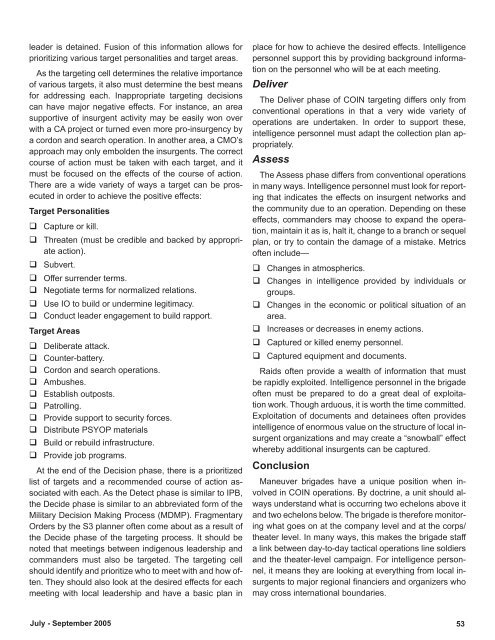Military Intelligence Professional Bulletin - Federation of American ...
Military Intelligence Professional Bulletin - Federation of American ...
Military Intelligence Professional Bulletin - Federation of American ...
You also want an ePaper? Increase the reach of your titles
YUMPU automatically turns print PDFs into web optimized ePapers that Google loves.
leader is detained. Fusion <strong>of</strong> this information allows for<br />
prioritizing various target personalities and target areas.<br />
As the targeting cell determines the relative importance<br />
<strong>of</strong> various targets, it also must determine the best means<br />
for addressing each. Inappropriate targeting decisions<br />
can have major negative effects. For instance, an area<br />
supportive <strong>of</strong> insurgent activity may be easily won over<br />
with a CA project or turned even more pro-insurgency by<br />
a cordon and search operation. In another area, a CMO’s<br />
approach may only embolden the insurgents. The correct<br />
course <strong>of</strong> action must be taken with each target, and it<br />
must be focused on the effects <strong>of</strong> the course <strong>of</strong> action.<br />
There are a wide variety <strong>of</strong> ways a target can be prosecuted<br />
in order to achieve the positive effects:<br />
Target Personalities<br />
� Capture or kill.<br />
� Threaten (must be credible and backed by appropriate<br />
action).<br />
� Subvert.<br />
� Offer surrender terms.<br />
� Negotiate terms for normalized relations.<br />
� Use IO to build or undermine legitimacy.<br />
� Conduct leader engagement to build rapport.<br />
Target Areas<br />
�<br />
�<br />
�<br />
�<br />
�<br />
�<br />
�<br />
�<br />
�<br />
�<br />
Deliberate attack.<br />
Counter-battery.<br />
Cordon and search operations.<br />
Ambushes.<br />
Establish outposts.<br />
Patrolling.<br />
Provide support to security forces.<br />
Distribute PSYOP materials<br />
Build or rebuild infrastructure.<br />
Provide job programs.<br />
At the end <strong>of</strong> the Decision phase, there is a prioritized<br />
list <strong>of</strong> targets and a recommended course <strong>of</strong> action associated<br />
with each. As the Detect phase is similar to IPB,<br />
the Decide phase is similar to an abbreviated form <strong>of</strong> the<br />
<strong>Military</strong> Decision Making Process (MDMP). Fragmentary<br />
Orders by the S3 planner <strong>of</strong>ten come about as a result <strong>of</strong><br />
the Decide phase <strong>of</strong> the targeting process. It should be<br />
noted that meetings between indigenous leadership and<br />
commanders must also be targeted. The targeting cell<br />
should identify and prioritize who to meet with and how <strong>of</strong>ten.<br />
They should also look at the desired effects for each<br />
meeting with local leadership and have a basic plan in<br />
place for how to achieve the desired effects. <strong>Intelligence</strong><br />
personnel support this by providing background information<br />
on the personnel who will be at each meeting.<br />
Deliver<br />
The Deliver phase <strong>of</strong> COIN targeting differs only from<br />
conventional operations in that a very wide variety <strong>of</strong><br />
operations are undertaken. In order to support these,<br />
intelligence personnel must adapt the collection plan appropriately.<br />
Assess<br />
The Assess phase differs from conventional operations<br />
in many ways. <strong>Intelligence</strong> personnel must look for reporting<br />
that indicates the effects on insurgent networks and<br />
the community due to an operation. Depending on these<br />
effects, commanders may choose to expand the operation,<br />
maintain it as is, halt it, change to a branch or sequel<br />
plan, or try to contain the damage <strong>of</strong> a mistake. Metrics<br />
<strong>of</strong>ten include—<br />
� Changes in atmospherics.<br />
� Changes in intelligence provided by individuals or<br />
groups.<br />
� Changes in the economic or political situation <strong>of</strong> an<br />
area.<br />
� Increases or decreases in enemy actions.<br />
� Captured or killed enemy personnel.<br />
�<br />
Captured equipment and documents.<br />
Raids <strong>of</strong>ten provide a wealth <strong>of</strong> information that must<br />
be rapidly exploited. <strong>Intelligence</strong> personnel in the brigade<br />
<strong>of</strong>ten must be prepared to do a great deal <strong>of</strong> exploitation<br />
work. Though arduous, it is worth the time committed.<br />
Exploitation <strong>of</strong> documents and detainees <strong>of</strong>ten provides<br />
intelligence <strong>of</strong> enormous value on the structure <strong>of</strong> local insurgent<br />
organizations and may create a “snowball” effect<br />
whereby additional insurgents can be captured.<br />
Conclusion<br />
Maneuver brigades have a unique position when involved<br />
in COIN operations. By doctrine, a unit should always<br />
understand what is occurring two echelons above it<br />
and two echelons below. The brigade is therefore monitoring<br />
what goes on at the company level and at the corps/<br />
theater level. In many ways, this makes the brigade staff<br />
a link between day-to-day tactical operations line soldiers<br />
and the theater-level campaign. For intelligence personnel,<br />
it means they are looking at everything from local insurgents<br />
to major regional financiers and organizers who<br />
may cross international boundaries.<br />
July - September 2005 53
















